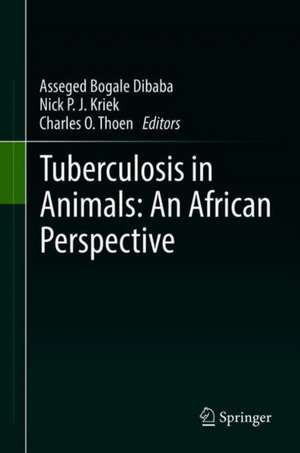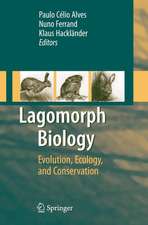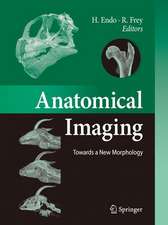Tuberculosis in Animals: An African Perspective
Editat de Asseged B. Dibaba, Nicolaas P. J. Kriek, Charles O. Thoenen Limba Engleză Hardback – 17 iul 2019
Preț: 1229.58 lei
Preț vechi: 1499.49 lei
-18% Nou
Puncte Express: 1844
Preț estimativ în valută:
235.30€ • 245.97$ • 198.84£
235.30€ • 245.97$ • 198.84£
Carte disponibilă
Livrare economică 14-28 februarie
Preluare comenzi: 021 569.72.76
Specificații
ISBN-13: 9783030186883
ISBN-10: 3030186881
Pagini: 475
Ilustrații: X, 453 p. 93 illus., 70 illus. in color.
Dimensiuni: 155 x 235 mm
Greutate: 0.79 kg
Ediția:1st ed. 2019
Editura: Springer International Publishing
Colecția Springer
Locul publicării:Cham, Switzerland
ISBN-10: 3030186881
Pagini: 475
Ilustrații: X, 453 p. 93 illus., 70 illus. in color.
Dimensiuni: 155 x 235 mm
Greutate: 0.79 kg
Ediția:1st ed. 2019
Editura: Springer International Publishing
Colecția Springer
Locul publicării:Cham, Switzerland
Cuprins
Section 1 Human and animal tuberculosis in Africa.- Introduction.- The current status of bovine tuberculosis in Africa.- Bovine TB Zoonosis in Africa.- The control of Mycobacterium bovis infections in Africa: a One Health approach.- Tuberculosis in African Wildlife.- The Mycobacterium tuberculosis Complex in Africa.- Section 2.- Epidemiology of bovine tuberculosis in Africa.- The epidemiology of bovine tuberculosis in Africa.- Molecular epidemiology of Mycobacterium bovis in Africa.- The diagnosis of bovine tuberculosis.- The control of bovine tuberculosis in Africa.- Section 3 Country reports.- Bovine tuberculosis: Status, epidemiology, and public health implications in Burkina Faso.- The status of bovine tuberculosis in Cameroon.- Bovine tuberculosis in Egypt.- The status of bovine tuberculosis in Ethiopia: Challenges and opportunities for its future control and prevention.- Bovine tuberculosis in Ghana.- The status of bovine tuberculosis in Malawi.- Bovine tuberculosis in Nigeria: Historical perspective, burden, risk factors, and challenges for its diagnosis and control.- Bovine tuberculosis in Rwanda.- BTB control strategies in livestock and wildlife in South Africa.- Bovine tuberculosis in the Republic of Sudan: A critical review.- A changing landscape of bovine tuberculosis in Tanzania.- Holes and patches: An account of tuberculosis caused by Mycobacterium bovis in Uganda.- Bovine tuberculosis in Zambia.
Recenzii
“The audience seems to include a broad range of people: students, researchers, and, potentially, policymakers. … I have been excited about this book; it is an essential reference for those doing research on zoonotic TB in Africa. There are no comparable books.” (Rebecca Lee Smith, Doody's Book Reviews, October 11, 2019)
Notă biografică
Prof. Asseged Bogale Dibaba
Center for Computational Epidemiology, Bioinformatics and Risk Analysis; College of Veterinary Medicine, Nursing and Allied Health; Tuskegee University, Tuskegee, USA.
Professor Dibaba received his Master of Science in epidemiology from Freie Universität Berlin Germany and received his Doctor of Veterinary Medicine from Addis Ababa University, Ethiopia. His research area is computational epidemiologic studies and risk analyses related to the import/export of agricultural products with regard to the introduction of exotic disease agents into the USA. The products in question range from conventional products (e.g., living animals, meat, milk) to non-conventional products (e.g., embryos and embryo-clones).
Another research area is bovine tuberculosis (bTB). The aim of this work is to elucidate the economic and public health significance of bTB and to recommend measures to control the disease, both in human and animal populations.
Prof. Nick P. J. Kriek
Emeritus Professor: Wildlife & Pathology, Faculty of Veterinary Science, University of Pretoria, South Africa
Professor Kriek received his Bachelor of Veterinary Science and M Med Vet (Path) from the University of Pretoria, South Africa and his Doctor of Philosophy from the Medical University of South Africa (MEDUNSA).
He is a specialist pathologist with the emphasis on African wildlife diseases.
Prof. Charles O. Thoen (1936-2017)
College of Veterinary Medicine, Iowa State University, Ames, Iowa, USA
Professor Thoen received his Bachelor of Science in Biology and Doctor of Veterinary Medicine degrees from the University of Minnesota before receiving his Doctor of Philosophy from the Mayo Graduate School of Medicine in Rochester, Minnesota, USA.
His research was mainly focused in the areas of veterinary microbiology and preventive medicine, pathobiology, immunology and preventive medicine. He has authored or co-authored over 130 publications on mycobacteria and mycobacterial diseases, as well as textbooks.
Center for Computational Epidemiology, Bioinformatics and Risk Analysis; College of Veterinary Medicine, Nursing and Allied Health; Tuskegee University, Tuskegee, USA.
Professor Dibaba received his Master of Science in epidemiology from Freie Universität Berlin Germany and received his Doctor of Veterinary Medicine from Addis Ababa University, Ethiopia. His research area is computational epidemiologic studies and risk analyses related to the import/export of agricultural products with regard to the introduction of exotic disease agents into the USA. The products in question range from conventional products (e.g., living animals, meat, milk) to non-conventional products (e.g., embryos and embryo-clones).
Another research area is bovine tuberculosis (bTB). The aim of this work is to elucidate the economic and public health significance of bTB and to recommend measures to control the disease, both in human and animal populations.
Prof. Nick P. J. Kriek
Emeritus Professor: Wildlife & Pathology, Faculty of Veterinary Science, University of Pretoria, South Africa
Professor Kriek received his Bachelor of Veterinary Science and M Med Vet (Path) from the University of Pretoria, South Africa and his Doctor of Philosophy from the Medical University of South Africa (MEDUNSA).
He is a specialist pathologist with the emphasis on African wildlife diseases.
Prof. Charles O. Thoen (1936-2017)
College of Veterinary Medicine, Iowa State University, Ames, Iowa, USA
Professor Thoen received his Bachelor of Science in Biology and Doctor of Veterinary Medicine degrees from the University of Minnesota before receiving his Doctor of Philosophy from the Mayo Graduate School of Medicine in Rochester, Minnesota, USA.
His research was mainly focused in the areas of veterinary microbiology and preventive medicine, pathobiology, immunology and preventive medicine. He has authored or co-authored over 130 publications on mycobacteria and mycobacterial diseases, as well as textbooks.
Textul de pe ultima copertă
This book recounts the biology of M. bovis, followed by the status of bovine Tuberculosis (bTB) in African countries, primarily based on zoonotic and epidemiological field reports. Since the accumulation of data is valueless unless it led to practicable control measures, emphasis is put on locally adapted protocols for future control of the disease. In order to systematically evaluate the knowledge base of bTB, Epidemiologic Problem Oriented Approach (EPOA) methodology was used. The methodology is composed of two triads: i) the problem identification/characterization triad, which is mainly descriptive in nature, and ii) the problem management/solution/mitigation triad, which is mainly geared toward problem management/solution (see figure). The first triad comprises three pillars: i) agent ii) host, and iii) environment and the second one: i) therapeutics/treatment, ii) prevention/control, and iii) health maintenance/promotion. The two triads are linked together by the diagnostic procedure linkage. The systematic and detailed studies of the ‘Host-Agent-Environment’ interactions are the building blocks to the understanding of agent transmission pathways and disease spread. These may include data about the disease status of the country, the nature of the disease agent and its hosts, the modes of transmission, the wildlife reservoirs in nature, persistence of infection, and agent survival in animal products and the environment. The problem identification and characterization triad identifies these interactions. Once a problem has been identified and well understood, the next step is to minimize the risk of transmission and spread of a disease. This area, referred to as problem solution/management triad, consists of problem management alternatives that rely upon prevention/control, and health maintenance/promotion of the disease in livestock, wildlife, and humans with the emphasis on resource-poor, developing countries in Africa.
Caracteristici
Deals with the disease status, epidemiologic pattern and zoonotic implications of Bovine Tuberculosis Combines fragmented evidence on Bovine Tuberculosis in developing countries using Epidemiologic Problem Orientated Approach (EPOA) methodology ? Emphasis is put on locally adapted protocols for future control of Bovine Tuberculosis





























